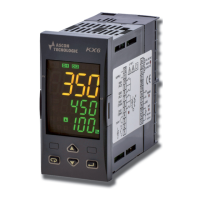Ascon Tecnologic - KX6 - ENGINEERING MANUAL - PAG. 11
• When no output is programmed as control output:
nonE Alarm not used;
LoAb Absolute low alarm;
HiAb Absolute high alarm;
LHAo Absolute band alarm with alarm indication
out of the band;
LHAi Absolute band alarm with alarm indication
inside the band;
SE.br Sensor break.
Note: The relative alarm are “relative” to the current set point.
[28] Ab2 - Alarm 2 function
Available: When [27] AL2t is different from nonE.
Range: 0... 15 with the following rule:
+1 Not active at power up;
+2 Latched alarm (manual reset);
+4 Acknowledgeable alarm;
+8
Relative alarm not active at set point change.
Example: Setting Ad2 equal to 5 (1+4) the alarm 2 will be
“not active at power up” and “Acknowledgeable”.
Note: For other details see [20] Ab1 parameter.
[29] AL2L - For High and low alarms, it is the low
limit of the AL2 threshold
-
For band alarm, it is low alarm threshold
Available: When [24] AL2t is different from nonE or
[24] AL2t is different from SE.br.
Range: -1999 to [27] AL2H engineering units.
[30] AL2H
- For High and low alarms, it is the high
limit of the AL2 threshold
-
For band alarm, it is high alarm threshold
Available: When [27] AL2t is different from nonE or
[27] AL2t is different from SE.br.
Range: From [26] AL2L to 9999 engineering units.
[31] AL2 - Alarm 2 threshold
Available: When:
[27] AL2t = LoAb Absolute low alarm;
[27] AL2t = HiAb Absolute high alarm;
[27] AL2t = LodE Deviation low alarm (relative);
[27] AL2t = LidE Deviation high alarm (relative).
Range: From [29] AL2L to [30] AL2H engineering units.
[32] HAL2 - Alarm 2 hysteresis
Available: When [27] AL2t is different to nonE or [27] AL2t
is different from SE.br.
Range: 1... 9999 engineering units.
Note: For other details see [24] HAL1 parameter.
[33] AL2d - Alarm 2 delay
Available: When [27] AL2t different from nonE.
Range: From oFF (0) to 9999 seconds.
Note: The alarm goes ON only when the alarm condition
persist for a time longer than [33] AL2d time but the
reset is immediate.
[34] AL2o - Alarm 2 enabling during Stand-by mode
and out of range indications
Available: When [27] AL2t different from nonE.
Range: 0 Never;
1 During stand by;
2 During overrange and underrange;
3
During overrange, underrange and stand-by.
] LbA group - Loop break alarm
General note about LBA alarm
The LBA operate as follows: applying the 100% of the power
output to a process, the process variable, after a time due to the
process inertia, begins to change in a known direction (increases
for an heating action or decreases for a cooling action).
Example: If I apply 100% of the power output to a furnace,
the temperature must go up unless one of the component in
the loop is faulty (heater, sensor, power supply, fuse, etc...)
The same philosophy can be applied to the minimum power.
In our example, when I turn OFF the power to a furnace, the
temperature must go down, if not the SSR is in short circuit,
the valve is jammed, etc..
LBA function is automatically enabled when the PID requires
the maximum or the minimum power.
When the process response is slower than the programmed
limit the instrument generates an alarm.
Notes: 1. When the instrument is in manual mode, the LBA
function is disabled.
2. When LBA alarm is ON the instrument continues
to perform the standard control. If the process
response comes back into the programmed limit,
the instrument automatically resets the LBA alarm.
[35] LbAt - LBA time
Available: Always.
Range: • oFF = LBA not used;
• 1... 9999 seconds.
[36] LbSt - Delta measure used by LBA during
Soft start
Available: When [35] LbAt is different from oFF.
Range: • oFF = loop break alarm is inhibit during soft start;
• 1... 9999 engineering units.
[37] LbAS - Delta measure used by loop break
alarm (loop break alarm step)
Available: When [35] LbAt is different from oFF.
Range: 1... 9999 engineering units.
[38] LbcA - Condition for LBA enabling
Available: When [35] LbAt is different from oFF.
Range: uP Enabled when the PID requires the maxi-
mum power only;
dn Enabled when the PID requires the mini-
mum power only;
both
Enabled in both condition (when the PID re-
quires the maximum or the minimum power).
LBA application example:
LbAt (LBA time) = 120 seconds (2 minutes);
LbAS (delta LBA) = 5°C.
The machine has been designed in order to reach 200°C in
20 minutes (20°C/min).
When the PID demands 100% power, the instrument starts
the time count.
During time count if the measured value increases more
than 5°C, the instrument restarts the time count. Otherwise
if the measured value does not reach the programmed delta
(5°C in 2 minutes) the instrument will generate the alarm.

